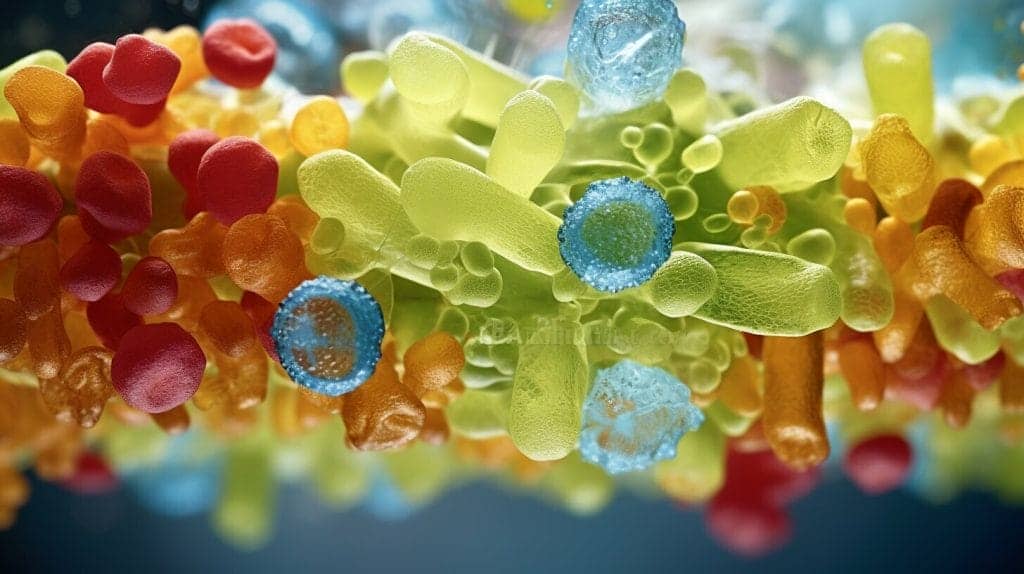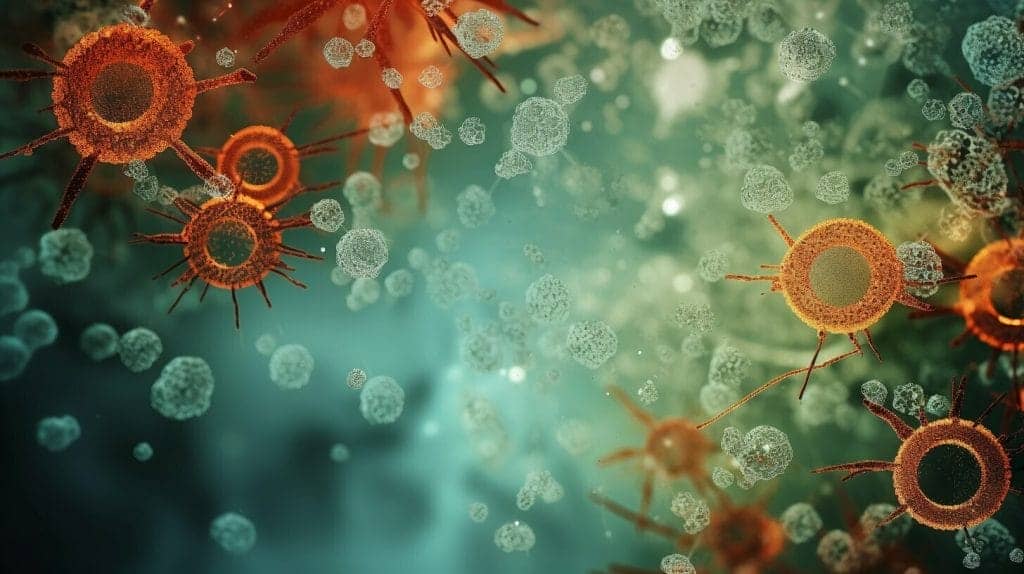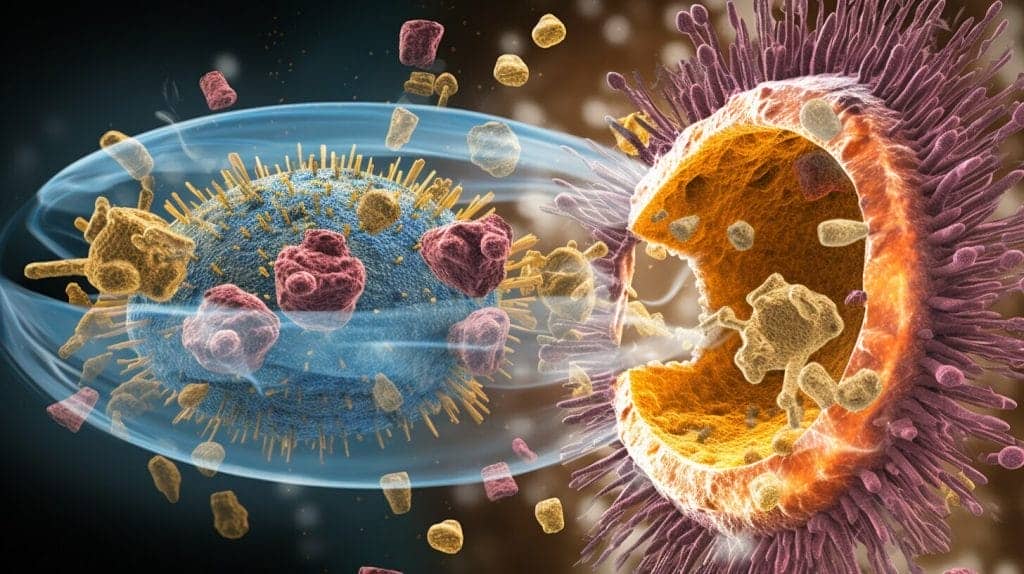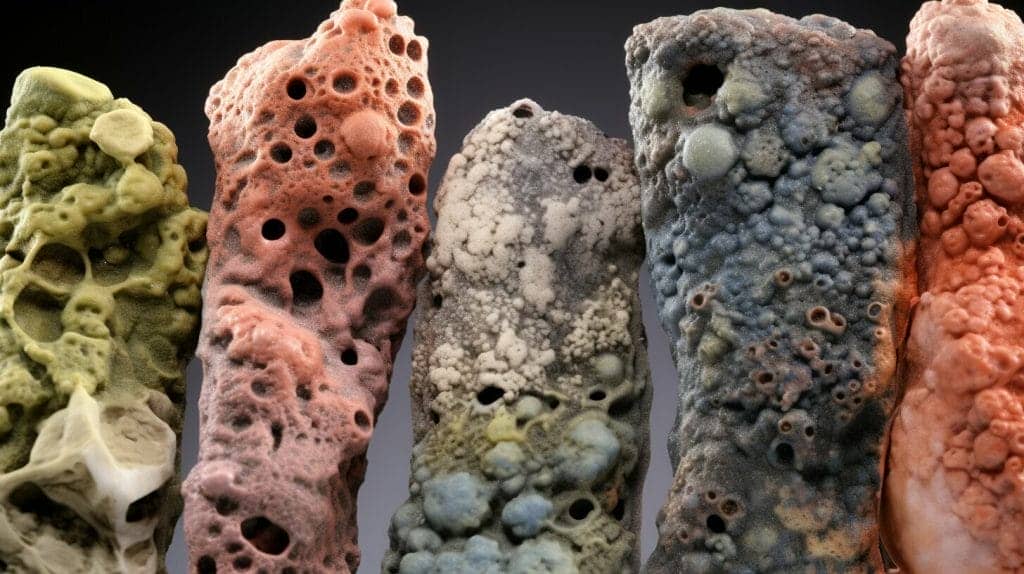Mycotoxins are toxic substances produced by certain types of molds. They can contaminate food sources, posing serious health risks to humans and animals. However, there is a solution to this problem: mycotoxin binding proteins.
These proteins have the unique ability to bind to mycotoxins, effectively removing them from food sources and ensuring food safety. Without mycotoxin binding proteins, the risks of mycotoxin contamination would be much higher, posing serious health risks to consumers.
Key Takeaways:
- Mycotoxin binding proteins are essential for ensuring food safety
- They have the ability to bind to mycotoxins, removing them from food sources
- The absence of mycotoxin binding proteins would increase the risks of mycotoxin contamination
Understanding Mycotoxin Binding Proteins
Mycotoxin binding proteins play a vital role in ensuring food safety by binding and neutralizing harmful mycotoxins present in food products. Understanding their mechanism of action is crucial in avoiding mycotoxin-related health risks and maintaining high-quality food standards.
These proteins bind to mycotoxins through various physical and chemical interactions, such as hydrogen bonding and van der Waals forces, resulting in the formation of non-toxic complexes that are eliminated from the body. Their effectiveness in reducing mycotoxin levels has been extensively studied, and they have been found to be highly efficient in binding multiple types of mycotoxins.
Moreover, mycotoxin binding proteins are stable and resistant to various processing conditions, such as heat and pH changes, making them ideal candidates for use in food production and processing. Their potential application in food and feed industry has been extensively explored, and research continues to uncover new ways of utilizing their properties for better food safety.
Types of Mycotoxin Binding Proteins
Mycotoxin binding proteins are classified into two main types: non-specific and specific. Non-specific binding proteins bind to a range of mycotoxins with varying affinities, while specific binding proteins bind to a specific mycotoxin or a group of structurally similar mycotoxins. Both types can be found in various food sources, including animal, plant, and microbial origin.
The non-specific binding proteins are generally more abundant and easier to isolate than specific binding proteins, making them more suitable for large-scale production and commercial use. However, the specific binding proteins have higher binding efficiency and selectivity, making them ideal for targeted mycotoxin removal and detection.
Understanding the different types of mycotoxin binding proteins is essential in identifying the best candidates for specific applications, ensuring their maximum effectiveness and safety.
Mycotoxin Binding Protein Research
The study of mycotoxin binding proteins is a rapidly growing field, driven by the need for effective solutions to food safety concerns. Researchers are exploring the potential of these proteins to neutralize harmful mycotoxins in various food sources.
Recent studies have focused on developing new methods for the detection and measurement of mycotoxin binding proteins in different food products. These methods include various biochemical and biophysical techniques, such as ELISA, Western blotting, and chromatography.
| Research Focus | Research Findings |
|---|---|
| Structural Properties of Mycotoxin Binding Proteins | These proteins have unique structural features that enable them to specifically interact with various mycotoxins, making them effective in mycotoxin removal. |
| Novel Mycotoxin Binding Proteins | Researchers have identified and characterized new mycotoxin binding proteins with potential applications in food safety, including plant-based proteins and microbial proteins. |
| Efficiency of Mycotoxin Binding Proteins | Studies have shown that mycotoxin binding proteins can efficiently bind and remove mycotoxins from contaminated food samples, leading to improved food safety standards. |
Further research is needed to fully understand the mechanisms and potential applications of mycotoxin binding proteins in the context of food safety. With ongoing advancements in the field, it is likely that these proteins will play a crucial role in mitigating the negative impact of mycotoxins on human health.
Mycotoxin Binding Protein Analysis
Mycotoxin binding proteins are crucial in ensuring food safety by binding and neutralizing harmful mycotoxins. To detect and quantify these proteins in various food products, laboratories employ several techniques and methods for mycotoxin binding protein analysis.
One commonly used technique is enzyme-linked immunosorbent assay (ELISA), a high-throughput method that involves the binding of specific antibodies to mycotoxin binding proteins. This allows for their quantification through colorimetric measurements.
Another technique is gel electrophoresis, which separates proteins based on their size and charge. This can be used to visually identify and characterize mycotoxin binding proteins in a sample.
Mass spectrometry is also used for mycotoxin binding protein analysis. It allows for the detection and identification of proteins through their mass-to-charge ratios and provides information on their structure and composition.
Significance of Mycotoxin Binding Proteins
Mycotoxin binding proteins play a crucial role in maintaining food safety standards. The significance of these proteins lies in their ability to bind and neutralize mycotoxins, preventing them from posing a health risk to consumers.
Mycotoxins are toxic compounds produced by certain molds that can contaminate various food sources, including grains, nuts, and fruits. These toxins can cause a range of health issues in humans and animals, including cancer, liver damage, and neurotoxicity. Therefore, it is essential to ensure that mycotoxin levels in food products remain within safe limits.
Mycotoxin binding proteins provide a natural method for eliminating mycotoxins from the food chain. These proteins bind to the mycotoxins, preventing them from being absorbed by the body. As a result, the mycotoxins are safely eliminated from the system, reducing the risk of health problems.
The significance of mycotoxin binding proteins extends beyond human health. They also play a vital role in maintaining high-quality food standards. The presence of mycotoxins can lead to spoilage and degradation of food products, reducing their shelf life and quality. By binding and neutralizing mycotoxins, these proteins ensure that food products remain safe and of high quality for consumers.
In summary, mycotoxin binding proteins are essential solutions for food safety. Their significance lies in their ability to eliminate mycotoxins from the food chain, reducing health risks and maintaining high-quality food standards.
Function of Mycotoxin Binding Proteins
Mycotoxin binding proteins are essential components in ensuring food safety. These proteins possess the capability to bind and neutralize mycotoxins, thereby eliminating the risks associated with mycotoxin contamination.
Their function in preventing the absorption of mycotoxins has made them a significant tool in food safety measures. These proteins act as a defense mechanism against harmful toxins, ensuring that they do not pose a threat to human health. The binding process between mycotoxin binding proteins and mycotoxins occurs in various stages, including food processing, storage, and consumption.
Mycotoxin binding proteins function through various mechanisms, including physical adsorption, chemical binding, and enzymatic degradation. Physical adsorption occurs when the mycotoxin binding protein directly binds to the mycotoxin molecule, preventing absorption. Chemical binding, on the other hand, utilizes the electrostatic interaction between the binding protein and the mycotoxin molecule to neutralize the toxin. Enzymatic degradation involves the transformation of the mycotoxin molecule into less toxic compounds, eliminating its harmful effects on the human body.
How Mycotoxin Binding Proteins Interact with Mycotoxins
The interaction between mycotoxin binding proteins and mycotoxins is dependent on several structural and biochemical factors. The size and shape of the mycotoxin molecule play a vital role in determining the effectiveness of binding proteins in neutralizing mycotoxins. The presence of functional groups in the mycotoxin molecule also influences the binding process, enabling the protein to recognize and eliminate the mycotoxin.
Additionally, the pH and temperature conditions of the environment in which these proteins interact with mycotoxins impact their function. Optimal pH and temperature conditions allow for optimal binding between the protein and mycotoxin, ensuring maximum toxin elimination.
Overall, mycotoxin binding proteins are crucial in ensuring food safety and mitigating health risks associated with mycotoxin contamination. Their function in binding and neutralizing mycotoxins, as well as their ability to interact with toxins in various stages of food production and processing, provides a reliable and effective method for ensuring high-quality and safe food products.
Importance of Mycotoxin Binding Proteins
Mycotoxin binding proteins play a crucial role in maintaining food safety standards. By binding and neutralizing mycotoxins, these proteins ensure that contaminated food products do not pose a threat to consumer health.
The significance of mycotoxin binding proteins lies in their ability to mitigate the health risks associated with mycotoxin contamination. Exposure to mycotoxins has been linked to a range of health issues, including liver damage, kidney problems, and cancer.
By preventing mycotoxin-related illnesses, mycotoxin binding proteins contribute to maintaining high-quality food standards. They ensure that the food products consumed by the public are safe, healthy, and free from harmful contaminants.
Given their importance in food safety, mycotoxin binding proteins are the subject of ongoing research and development. Scientists are constantly working to develop new and more effective methods of detecting, quantifying, and utilizing these proteins to improve food safety measures.
Overall, the significance of mycotoxin binding proteins cannot be overstated. They are a critical component of ensuring food safety and protecting consumer health.
Mycotoxin Binding Protein Detection
Detecting mycotoxin binding proteins is crucial in ensuring food safety. Several laboratory techniques are employed to achieve accurate and reliable results.
One method is the Enzyme-linked immunosorbent assay (ELISA), which is based on the interaction between the target protein and specific antibodies. This technique involves the use of a specialized antibody that binds specifically to the mycotoxin binding protein.
Another technique is the Western blot, which involves the separation of proteins based on molecular weight and charge. This technique involves the transfer of protein samples onto a membrane and subsequent use of specific antibodies to detect the target protein.
Mass spectrometry is also used for the quantification and identification of mycotoxin binding proteins. This technique involves the ionization of the protein sample and separation of the ions based on mass-to-charge ratio.
Overall, the analysis and detection of mycotoxin binding proteins play a crucial role in ensuring food safety, allowing for early and accurate detection of contaminated food products.
Role of Mycotoxin Binding Proteins
Mycotoxin binding proteins play a crucial role in ensuring food safety by eliminating mycotoxins from the food chain. These proteins bind to mycotoxins and neutralize their harmful effects, preventing them from being absorbed by the body and causing health issues.
One important function of mycotoxin binding proteins is in the production and processing of animal feed. By reducing mycotoxin levels in animal feed, these proteins prevent mycotoxin contamination in animal-derived products, such as meat, milk, and eggs.
Mycotoxin binding proteins also have a significant role in preserving the quality of food products during storage and transportation. By preventing the growth of mycotoxin-producing fungi, these proteins keep food safe and ensure longer shelf-life.
Mycotoxin Binding Proteins in Agriculture
The use of mycotoxin binding proteins is becoming increasingly widespread in agriculture, with many farmers adopting these proteins as a preventative measure against mycotoxin contamination. By using these proteins in crops and soil, farmers can limit the growth of fungi and reduce the risk of mycotoxin contamination in food products.
- Reduce the growth of fungi in crops and soil
- Limit the spread of mycotoxin contamination in food products
- Improve crop yields and quality
The use of mycotoxin binding proteins in agriculture is a sustainable and effective approach to reducing mycotoxin contamination in the food supply chain.
Mycotoxin Binding Protein Mechanisms
Mycotoxin binding proteins play a crucial role in food safety by binding and neutralizing mycotoxins. These proteins work by disrupting the structure and function of mycotoxins, preventing their absorption and potentially harmful effects on humans and animals.
The mechanisms by which mycotoxin binding proteins operate are complex and involve various structural and biochemical aspects. These proteins contain specific binding sites that allow them to attach to different types of mycotoxins, forming stable complexes and effectively removing them from food sources.
Studies have shown that mycotoxin binding proteins can operate through different mechanisms, including physical encapsulation, electrostatic interactions, and molecular recognition. Physical encapsulation involves the coating of mycotoxins with the protein, preventing them from interacting with other molecules in the food matrix. Electrostatic interactions rely on the attractive forces between positively charged proteins and negatively charged mycotoxins. Molecular recognition, on the other hand, involves the specific recognition and binding of mycotoxins by the protein’s binding sites.
Structural Aspects
The structure of mycotoxin binding proteins is crucial to their function and effectiveness. These proteins are typically composed of multiple domains that work together to bind and neutralize mycotoxins. The domains may have different conformations or shapes that enable them to interact with various types of mycotoxins or have distinct chemical properties.
The structure of mycotoxin binding proteins may also be modified to enhance their binding capacity or specificity. Scientists have explored various modifications, including genetic engineering, to improve the performance of these proteins in food safety applications.
Biochemical Aspects
Several biochemical processes are involved in the interaction between mycotoxin binding proteins and mycotoxins. These processes include the formation of hydrogen bonds, van der Waals interactions, and hydrophobic interactions.
Hydrogen bonds are formed between the binding sites of the protein and the functional groups of the mycotoxin molecules. Van der Waals interactions involve weak attractive forces between the protein and mycotoxin molecules due to differences in electron density. Hydrophobic interactions occur between non-polar regions of the protein and mycotoxin molecules that have similar properties.
The biochemical aspects of mycotoxin binding protein mechanisms are critical to their ability to neutralize and remove mycotoxins from food sources. These processes are influenced by various factors such as pH, temperature, and the concentration of the protein and mycotoxin.
In conclusion, mycotoxin binding proteins are essential solutions for food safety, and their mechanisms of action are complex and multi-faceted. The structural and biochemical aspects involved in the interaction between these proteins and mycotoxins are crucial to their effectiveness and potential applications in food safety measures.
Holistic Treatments at Oasis Medical Institute, Tijuana, MX
In addition to the use of mycotoxin binding proteins for food safety, holistic treatment options for mold toxicity are also available at Oasis Medical Institute in Tijuana, MX.
Dr. Francisco Contreras MD leads the integrative approach, combining various medical and holistic techniques to address mold-related health issues. The comprehensive program offered for mold toxicity treatment includes a range of therapies such as ozone therapy, IV nutrient therapy, and detoxification.
At Oasis Medical Institute, the focus is on healing the whole person, not just the symptoms of mold toxicity. This holistic approach emphasizes the importance of a healthy lifestyle, including nutrition, exercise, and stress management.
Book a consultation for the holistic Mold Toxicity treatment program at Oasis Medical Institute in Tijuana, MX to benefit from their comprehensive approach to treating mold toxicity.
Integrative Approach for Mold Toxicity with Dr. Francisco Contreras MD
At Oasis Medical Institute in Tijuana, MX, Dr. Francisco Contreras MD leads an integrative approach to treat mold toxicity. This approach combines various medical and holistic techniques to address mold-related health issues in a comprehensive manner.
Dr. Contreras MD works with a team of experts to provide personalized treatment plans for each patient, addressing their unique needs and health concerns. The team includes nutritionists, naturopaths, and other health professionals, ensuring patients receive an integrated treatment approach.
The integrative approach to mold toxicity treatment at Oasis Medical Institute includes a combination of conventional and alternative medicine, such as detoxification protocols, immune system support, and nutritional therapy. Patients receive individualized care that targets the root cause of their symptoms, promoting healing and a return to optimal health.
Dr. Contreras MD’s approach to mold toxicity treatment extends beyond just addressing physical symptoms. He also focuses on addressing the emotional and spiritual needs of his patients, using a compassionate and caring approach that encourages healing on all levels.
Overall, the integrative approach to mold toxicity treatment with Dr. Francisco Contreras MD provides patients with a comprehensive and effective way to address mold-related health concerns. By combining conventional and alternative treatments, patients receive personalized care that promotes healing and a return to optimal health.
Book Consultation for Holistic Mold Toxicity Treatment Program
If you are suffering from mold toxicity, it is crucial to seek professional help to address your health concerns. At Oasis Medical Institute in Tijuana, MX, Dr. Francisco Contreras MD leads a comprehensive and integrative program for Mold Toxicity treatment.
To book a consultation for the holistic Mold Toxicity treatment program, please contact the institute at your earliest convenience. With a focus on personalized care and a patient-centered approach, the program aims to help you regain your health and restore your quality of life.
Don’t wait any longer to take control of your Mold Toxicity symptoms. Book your consultation today and start on the path to a healthier, happier you.
Conclusion
In conclusion, mycotoxin binding proteins play a crucial role in ensuring food safety by binding and neutralizing harmful mycotoxins. Understanding their mechanisms and functions is essential for developing effective solutions to prevent mycotoxin-related illnesses. Ongoing research in the field continues to provide new insights into the effectiveness and potential applications of these proteins in food safety measures. The significance of mycotoxin binding proteins cannot be overstated, as they contribute to maintaining high-quality food standards and protecting consumer health.
For those seeking holistic treatment options for mold toxicity, Oasis Medical Institute in Tijuana, MX offers an integrative approach led by Dr. Francisco Contreras MD. Their comprehensive program combines various medical and holistic techniques to address mold-related health issues. To book a consultation for the holistic Mold Toxicity treatment program, readers can contact Oasis Medical Institute for more information.
Overall, mycotoxin binding proteins and holistic treatment options offer solutions to mitigate health risks associated with mycotoxin contamination and promote overall wellness. It is crucial to prioritize food safety and seek professional help when dealing with mold-related health concerns.
FAQ
Q: What are mycotoxin binding proteins?
A: Mycotoxin binding proteins are a class of proteins that have the ability to bind and neutralize mycotoxins, which are toxic substances produced by certain types of fungi. These proteins play a crucial role in ensuring food safety by preventing the harmful effects of mycotoxins on human and animal health.
Q: How do mycotoxin binding proteins work?
A: Mycotoxin binding proteins work by binding to mycotoxins and forming complexes that are unable to interact with their target molecules or organisms. This prevents the mycotoxins from being absorbed and distributed in the body, thereby reducing the risk of toxicity.
Q: What is the significance of mycotoxin binding proteins in food safety?
A: Mycotoxin binding proteins are of great significance in food safety as they help mitigate the health risks associated with mycotoxin contamination in food products. By binding and neutralizing mycotoxins, these proteins help maintain high-quality food standards and protect consumer health.
Q: How are mycotoxin binding proteins detected and analyzed?
A: The detection and analysis of mycotoxin binding proteins involve various laboratory techniques and methods. These may include enzyme-linked immunosorbent assay (ELISA), immunoblotting, and mass spectrometry, among others. These techniques enable the identification and characterization of mycotoxin binding proteins in different food samples.
Q: What is the function of mycotoxin binding proteins?
A: The function of mycotoxin binding proteins is to bind and neutralize mycotoxins, preventing their absorption and ensuring their safe elimination from the food chain. These proteins act as natural defense mechanisms against mycotoxin contamination and play a crucial role in maintaining food safety.
Q: What is the role of mycotoxin binding proteins in the food production and processing chain?
A: Mycotoxin binding proteins have various roles in the food production and processing chain. They can be used in different stages, from raw material selection to finished product quality control, to ensure that mycotoxin contamination is kept at a minimum. These proteins contribute to preventing mycotoxin-related illnesses and protecting consumer health.
Q: How can I book a consultation for holistic Mold Toxicity treatment at Oasis Medical Institute?
A: To book a consultation for holistic Mold Toxicity treatment at Oasis Medical Institute in Tijuana, MX, please contact our office at [insert contact information]. Our team will be happy to assist you and provide more information about our comprehensive program for Mold Toxicity treatment.
Dr. Francisco Contreras, MD is a renowned integrative medical physician with over 20 years of dedicated experience in the field of integrative medicine. As the Medical Director of the Oasis of Hope Hospital in Tijuana, Mexico, he has pioneered innovative treatments and integrative approaches that have been recognized globally for the treatment of cancer, Lyme Disease, Mold Toxicity, and chronic disease using alternative treatment modalities. Dr. Contreras holds a medical degree from the Autonomous University of Mexico in Toluca, and speciality in surgical oncology from the University of Vienna in Austria.
Under his visionary leadership, the Oasis of Hope Hospital has emerged as a leading institution, renowned for its innovative treatments and patient-centric approach for treating cancer, Lyme Disease, Mold Toxicity, Long-Haul COVID, and chronic disease. The hospital, under Dr. Contreras's guidance, has successfully treated thousands of patients, many of whom traveled from different parts of the world, seeking the unique and compassionate care the institution offers.
Dr. Contreras has contributed to numerous research papers, articles, and medical journals, solidifying his expertise in the realm of integrative medicine. His commitment to patient care and evidence-based treatments has earned him a reputation for trustworthiness and excellence. Dr. Contreras is frequently invited to speak at international conferences and has been featured on CNN, WMAR2 News, KGUN9 News, Tyent USA, and various others for his groundbreaking work. His dedication to the medical community and his patients is unwavering, making him a leading authority in the field.
Contreras has authored and co-authored several books concerning integrative therapy, cancer, Lyme Disease and heart disease prevention and chronic illness, including "The Art Science of Undermining Cancer", "The Art & Science of Undermining Cancer: Strategies to Slow, Control, Reverse", "Look Younger, Live Longer: 10 Steps to Reverse Aging and Live a Vibrant Life", "The Coming Cancer Cure Your Guide to effective alternative, conventional and integrative therapies", "Hope Medicine & Healing", "Health in the 21st Century: Will Doctors Survive?", "Healthy Heart: An alternative guide to a healthy heart", “The Hope of Living Cancer Free”, “Hope Of Living Long And Well: 10 Steps to look younger, feel better, live longer” “Fighting Cancer 20 Different Ways”, "50 Critical Cancer Answers: Your Personal Battle Plan for Beating Cancer", "To Beat . . . Or Not to Beat?", and “Dismantling Cancer.”









